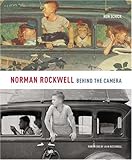Among the magazine covers included in the exhibition are several from The Saturday Evening Post, for which Rockwell worked for nearly fifty years before turning his attentions to more socially relevant subjects for Look magazine, with which he had a decade-long relationship. Included is The Art Critic, showing an aspiring artist scrutinizing paintings in a gallery, which appeared in the April 16, 1955, issue. The exhibition also includes several series of photographs and the final paintings and magazine tear sheets, among them the July 13, 1946, Saturday Evening Post illustration Maternity Waiting Room, shown along with a series of images by an unidentified photographer that served as details of the final work, which portrays ten anxious soon-to-be fathers.
Norman Rockwell became one of the most famous illustrators of his generation through his naturalistic, narrative paintings done in a readily recognizable style, which appeared in national magazines that reached millions of readers. Born in 1894 on Manhattan’s Upper West Side, he left high school to study at the National Academy of Design and later the Art Students League of New York. By the age of eighteen he was already a published artist specializing in children’s illustration and had become a regular contributor to magazines such as Boys’ Life, the monthly magazine of the Boy Scouts of America, where he was soon named art director. In 1916 he painted his first cover for The Saturday Evening Post, beginning a forty-seven-year relationship that resulted in 323 covers and was the centerpiece of his career.
Early in his career Rockwell had a studio in New Rochelle, New York. He later moved with his wife and three sons to Arlington, Vermont, where many of his family and neighbors served as models in working photographs for his illustrations, which began to focus on small-town American life. In 1943 a fire destroyed his Vermont studio, along with numerous paintings and many of the photographic studies.
A decade later the family relocated to Stockbridge, Massachusetts. In 1963 he severed his forty-seven-year association with The Saturday Evening Post and began to work for Look magazine, where, during his ten-year association, he produced work that reflected his personal concerns, including civil rights, America’s war on poverty, and space exploration.
Norman Rockwell: Behind the Camera by Ron Schick
Norman Rockwell: Behind the Camera was organized by the Norman Rockwell Museum. Conceived in collaboration with Ron Schick, guest curator for the Norman Rockwell Museum and author of the accompanying publication, the exhibition reveals a rarely seen yet fundamental aspect of Rockwell’s creative process and unveils a significant new body of Rockwell imagery through the medium of photography. The Brooklyn Museum presentation is organized by Sharon Matt Atkins, Acting Head of Exhibitions and Managing Curator.
Pages: 1 · 2
More Articles
- National Portrait Gallery Presents “Brilliant Exiles: American Women in Paris, 1900–1939"
- The Guggenheim Museum Exhibits and Store in New York City; Works & Process Commissions on Tour
- Julia Sneden Wrote: Love Your Library
- Rebecca Louise Law: Awakening on View at Honolulu Museum of Art
- Annandale-on-Hudson, New York ... With Pleasure: Pattern and Decoration in American Art 1972 - 1985
- Lynn Hershman Leeson: Who Has Celebrated Her 80th Birthday and a New Exhibition, TWISTED, at The New Museum in New York City
- New York's Jewish Museum: Photography and the American Magazine; When Avant-garde Techniques in Photography and Design Reached the United States via European Emigrés
- Explore the Royal Collection and an Exhibition, Masterpieces From Buckingham Palace
- Ferida Wolff's Backyard: Mushroom Hunt; Grasshoppers Leap Into the Future (on glass!)
- The Autobiography of a Garden at The Huntington, a Joy for Viewers and Gardeners






